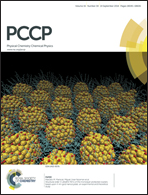The effect of polyaromatic hydrocarbons on the spectral and photophysical properties of diaryl-pyrrole derivatives: an experimental and theoretical study†
Abstract
A new class of diaryl-pyrrole derivatives of the polyaromatic hydrocarbons (PAH) benzene, naphthalene, anthracene and pyrene were synthesized in a multicomponent reaction under microwave irradiation and studied in solution at room (293 K) and low (77 K) temperature. The study includes a complete spectroscopic evaluation (singlet–singlet and triplet–triplet absorption, fluorescence and phosphorescence spectra) as well as photophysical evaluation (fluorescence, phosphorescence and triplet lifetimes together with fluorescence and triplet occupation and singlet oxygen sensitization quantum yields). From the above evaluation, a complete set of deactivation rate constants (kF, kIC and kISC) could be obtained. The study was further complemented with TDDFT calculations. It is shown that, with the exception of the anthracene derivative, the diaryl-pyrrole moiety strongly influences the spectral and photophysical properties of the PAH and that with the exception of the benzene derivative, the excited state internal conversion deactivation channel of the diaryl-pyrrole derivatives is higher than that of the PAH counterparts.


 Please wait while we load your content...
Please wait while we load your content...